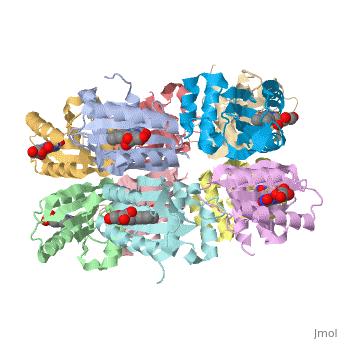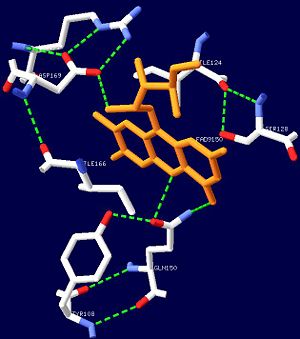Cyanobacterial BLUF
From Proteopedia
| |||||||||
| 1x0p, resolution 2.00Å () | |||||||||
|---|---|---|---|---|---|---|---|---|---|
| Ligands: | |||||||||
| |||||||||
| |||||||||
| Resources: | FirstGlance, OCA, RCSB, PDBsum | ||||||||
| Coordinates: | save as pdb, mmCIF, xml | ||||||||
Contents |
Introduction
The proteins containing sensors for blue light using FAD (BLUF) domains are one class of photoreceptor family that utilizes a flavin chromophore[1]. The other two classes include phototropins (LOV) and cryptochromes[2]. The BLUF domain was first discovered in Rhodobacter sphaeroides as the blue light photoreceptor involved in the repression of photosynthesis genes in AppA protein[1][3]. The BLUF domain is known to exist in many bacteria, including cyanobacteria.
One unique photosensing property of BLUF domain is a light induced spectral shift in the flavin absorption spectrum where the wavelength is longer by approximately 10nm[1]. In AppA this shift occurs quickly upon illumination and is slowly reversed upon return to darkness. This spectral shift is not well understood and is not observed in other flavin binding photoreceptors. There have been two proposed models to explain the spectral shift observed in BLUF containing proteins: π-π stacking between the isoalloxazine ring of flavin and the phenol sidechain of a conserved tyrosine residue or protonation and deprotonation of the flavin ring coupled directly or indirectly with the conserved tyrosine residue[4][5]. These two models are based upon the conserved tyrosine residue Tyr9 in the T110078 protein.
The BLUF domain can be divided into two categories: a multidomain protein, such as those found in the AppA from R. sphaeroides, photoactivated adenylyl cyclase (PACα and PACβ) from Euglena gracilis and YcgF proteins of Escherichia coli, and a “short” protein composed of BLUF at the N-terminus[6]. The amino acid sequences for each BLUF domain is unique, thus it is hard to discuss the role of the conserved tyrosine residue. The crystalline structure of the BLUF domain was solved using the “short” BLUF protein T110078 isolated from Thermosynechococcus elongatus BP-1[1]. T. elongatus is a thermophyllic cyanobacteria with an optimum growth temperature near 57°C. Specifically, the T11078 protein is comprised of 143 amino acid residues and binds an oxidized FAD ligand non-covalently[1].
Structure
Domains
The BLUF domain is a with a molecular weight of approximately 160kDa[1]. There are ten monomers observed in each asymmetric unit. The crystalline structure of the BLUF domain from the T110078 protein was solved by single isomorphous replacement (SIR) method using a mercury derivative. The double ringed decamer has a diameter of approximately 95Å, a thickness of 60Å and a central channel approximately 35Å in diameter[1]. Each monomer is comprised of 5 and 4 in the order of β1α1β2β3α2β4β5α3α4. Specifically, the BLUF domain of the monomer contains β1α1β2β3α2β4β5, while the C-terminal domain contains α3α4[1]. The C-terminal domain interacts with the end of the β-sheet of the neighbouring monomer.
The isoalloxazine ring of FAD is located between of the BLUF domain, between two highly conserved hydrophobic residues: Ile24 and Ile66[1]. FAD forms hydrogen bonds with the following amino acid residues: Asn21, Asn32, Gln50, Arg65 and Asp69 (Figure 1)[1]. More specifically, the side chain of Asn31 binds to O2 of FAD and Asn32 binds to N3 and O4 of FAD. The guanido group of Arg65 contributes to a network between FAD and the apo protein. The amide N of the Gln50 sidechain interacts with N5 and O4 of FAD through hydrogen bonding, while the amide O of the sidechain is closely linked with the hydroxyl oxygen of the highly conserved Tyr8 residue, forming a FAD-Gln50-Tyr8 network[1]. This conserved Tyr8 residue is the only residue that has been shown to be essential for light reaction in the BLUF domain containing AppA and Slr1694 proteins[7].
Further Analyses
While Asn32, Gln50, Asp69, Arg71, His72 and Ser10 are completely conserved residues, Asn31, Arg65 and Ser28 are only moderately conserved. This network surrounding FAD is thought to be highly conserved in all BLUF domains. In order to study the importance of the interactions between the isoalloxaizine ring of FAD, and Asn31, Asn32 and Gln50, the amino acids were replaced with alanine residues[1]. It was observed that the spectra of the mutants were qualitatively similar to that of the wild-type. However, the low energy absorbance peak of N32A (Asn32 replaced with Ala) was blue shifted compared to the wildtype by 6nm[1]. This blue shift can be accounted for by the lack of hydrogen bonding between the side-chain and isoalloxazine ring[1]. In the wild-type protein, Asn32 forms 2 hydrogen bonds with FAD; the absence of these bonds allows relocation of an electron on FAD, resulting on the spectral blue shift.
The Q40A mutant showed very little spectral changes during illumination. These results suggest that Gln50 is critical for light reaction in BLUF domains and is thus totally conserved[1]. Transient bleaching of flavin was observed instead of red-shifting; this suggests that light excitation of flavin in Q50A resulted in photoreduction of flavin[1]. In general, a free flavin in solution is sequentially reduced with two electrons upon exposure to light. The first electron reduces the double bond at N5 and the second electron reduces at N1 of the isoalloxazine ring. In BLUF proteins, the role of Gln50 may be to prevent the initial photoreduction at N5 and allow a reaction leading to the spectral shift to a longer wavelength. This may be achieved by the hydrogen bonding between the amide N of Gln50 and the N5 of the isoalloxazine ring of FAD.
Similar hydrogen bonding networks surrounding the isoalloxazine ring are found in other light sensing proteins such as the LOV proteins[1]. The most critical residue in the flavin sensor proteins appears to be the one that interacts closely with N5 of the isoalloxazine ring[1].
Function
Overall, the main function of the BLUF domain is to detect and respond to blue light. More specifically, in R. sphaeroides, the BLUF domain is a blue light photo receptor involved in repressing the photosynthesis genes at the N-terminal region of the AppA protein[3]. In E. gracilis, the BLUF domain of PAC complexes serves as a blue light receptor in photophobic responses[6].
References
- ↑ 1.00 1.01 1.02 1.03 1.04 1.05 1.06 1.07 1.08 1.09 1.10 1.11 1.12 1.13 1.14 1.15 1.16 1.17 Kita A, Okajima K, Morimoto Y, Ikeuchi M, Miki K. Structure of a cyanobacterial BLUF protein, Tll0078, containing a novel FAD-binding blue light sensor domain. J Mol Biol. 2005 May 27;349(1):1-9. Epub 2005 Apr 9. PMID:15876364 doi:10.1016/j.jmb.2005.03.067
- ↑ van der Horst MA, Hellingwerf KJ. Photoreceptor proteins, "star actors of modern times": a review of the functional dynamics in the structure of representative members of six different photoreceptor families. Acc Chem Res. 2004 Jan;37(1):13-20. PMID:14730990 doi:10.1021/ar020219d
- ↑ 3.0 3.1 Masuda S, Bauer CE. AppA is a blue light photoreceptor that antirepresses photosynthesis gene expression in Rhodobacter sphaeroides. Cell. 2002 Sep 6;110(5):613-23. PMID:12230978
- ↑ Laan W, van der Horst MA, van Stokkum IH, Hellingwerf KJ. Initial characterization of the primary photochemistry of AppA, a blue-light-using flavin adenine dinucleotide-domain containing transcriptional antirepressor protein from Rhodobacter sphaeroides: a key role for reversible intramolecular proton transfer from the flavin adenine dinucleotide chromophore to a conserved tyrosine? Photochem Photobiol. 2003 Sep;78(3):290-7. PMID:14556317
- ↑ Hasegawa K, Masuda S, Ono TA. Spectroscopic analysis of the dark relaxation process of a photocycle in a sensor of blue light using FAD (BLUF) protein Slr1694 of the cyanobacterium Synechocystis sp. PCC6803. Plant Cell Physiol. 2005 Jan;46(1):136-46. Epub 2005 Jan 19. PMID:15659451 doi:10.1093/pcp/pci003
- ↑ 6.0 6.1 Iseki M, Matsunaga S, Murakami A, Ohno K, Shiga K, Yoshida K, Sugai M, Takahashi T, Hori T, Watanabe M. A blue-light-activated adenylyl cyclase mediates photoavoidance in Euglena gracilis. Nature. 2002 Feb 28;415(6875):1047-51. PMID:11875575 doi:10.1038/4151047a
- ↑ Yuan H, Anderson S, Masuda S, Dragnea V, Moffat K, Bauer C. Crystal structures of the Synechocystis photoreceptor Slr1694 reveal distinct structural states related to signaling. Biochemistry. 2006 Oct 24;45(42):12687-94. PMID:17042486 doi:10.1021/bi061435n
This page originally authored by Amanda Cookhouse



